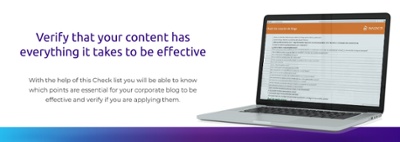How to measure the effectiveness of your Sales Process
If you already have a sales process defined in your company, that is, you know when a customer goes from being a potential customer to a closed...
10 min read
Por Susana Matamoros | Sep 16, 2020
Blogs have been proven to be an infallible tool, nowadays people buy after having researched a product, 70% of consumers learn about companies through articles (not advertising) and the companies they use Blogs are 13 times more likely to achieve positive ROI (return on investment for its acronym in English) also increasing 434% the chances of reaching a good position in search engines.
Now that you know why it's important, tell me what do you want to write about? Don't you know yet?Don't worry, I'm here to help you, the first thing to keep in mind is that every blog you write must be planned and must have a creative and SEO process in it. While each person's writing style is unique, there are certain characteristics that can achieve surprising results. Follow the good practices of blogging with these 10 easy steps and show the world your creation.
1. Plan the content
2.Consider your Buyer Persona
3. Create an outline
4. Write
5. Check the length, narrative and spelling
6. Create a title and meta description for your blog
7. Use the subtitle format
8. Add images and optimize them
9. Invite to action
10. Optimize SEO
As we have mentioned before, the blog should become an important part of your company. We know that day-to-day work, unforeseen events and the lack of ideas can play against the regularity of your blogs, however when you achieve good management of the information that you want to offer to your users, there is a great probability that avoid improvisation and prevent this lack of regularity. In addition, the continuous publication of blogs will allow you to increase the probability that you will gain more authority in the search engines, maintain the engagement of your target audience and get more leads.
Keeping an adequate control of your publications through an editorial calendar will help you, among other things, to keep an order of the topics that you have dealt with and want to deal with. This will allow you to identify what you have posted and not repeat it; then you will be able to link the content according to its similarities, thus creating the internal links that Google likes so much.
In several articles we have shared the importance of creating quality content for your Buyer Persona, if you still do not know what a Buyer Persona is, I invite you to learn more in the article Buyer Persona: Key to the success of your business strategy.
To achieve your commercial objectives, the content generated must always help your audience solve their problems or meet their needs, remember they are different people with particular interests, so you must know them well and, above all, know what they need in every moment according to your Journey Map. When you identify and study your Buyer Persona, he himself will be the one who provides you with the inputs to work.
Of your current clients for example, what are their concerns? Where they live? What topics could offer you value? Have you been asked repetitive questions about a product or service?
These questions will later help you to generate ideas to help your clients to evacuate their doubts quickly, which in the end translates into confidence towards your service or product, so do not forget to write them down for future use.
Another important aspect when writing your blog is to understand your Buyer Persona's reading style. Are they housewives, busy managers or idle teenagers? Each audience group has different behaviors, so think about their time available for reading, their circumstances when consuming this content and the needs they hope to satisfy.
Do you have the content ideas? Then it is time to choose one and create your outline.
If it is your first post, we recommend that you write about something that you are passionate about and that you have a lot of knowledge about, lest you want to abandon it when you are only 150 words long.
Develop the idea by detailing the sub-points of the topic and list additional information. Order and determine where each subpoint should go for consistency in the reading. A common pattern could be:
By segmenting your information, you will have a clearer picture and the writing step will be more fluid.Some recommendations when writing your introduction, development and conclusion are:
Grab their attention If you lose your reader after they read the first few paragraphs or even the first sentences of the introduction, they will stop reading before they even give your post a chance. You can do this in different ways: tell a story or joke, be empathetic, or captivate the reader with an interesting fact or statistic.
Then describe the purpose of the post and explain how it will address an issue that the reader might be experiencing.
Organize your content so that readers aren't intimidated by the length or quantity of content. You can organize the information in several ways: sections, lists, tips or whatever is most appropriate for you.Remember to use titles for each of those subtopics that you will cover.
This way, before you start writing, you will know what points you want to cover and what will be the best order to develop them.
Call it a conclusion: The best conclusions are directly labeled "Conclusion", either with a heading or with the phrase "In conclusion."
Keep it short: When you are done with all your main points, the actual end of the article should be short and ideally it should not include any new information.
To help you breathe at the end, make some personal comments.
Please don't put any photo on it. Adding images to the conclusion adds unnecessary length and makes the conclusion appear longer than necessary.
Make any beneficial or necessary disclaimer: A disclaimer is a way to clarify what you are saying so that you can be sure that your readers get the right message from your post.
Summarize the article: They allow you to reinforce your message and make it memorable. Your article is about one main thing, so you should remind your users at the end of the article.
If the blog allows you to ask a question, questions demand answers, so placing them in their conclusion gets people's minds moving. The whole motivation for writing an article is to change someone's behavior, and I consider the question to be one of the most effective ways to do it.
Now that you know what you want to write about and have arranged the ideas, the next step is to write. Do your research first and gather more information, examples, and data to support your points.
Write and ignore the urge to self-edit, let the ideas flow, the draft review will take place later. Write using your own unique voice, but don't forget who you are speaking to. Set aside a specific time of your day and type without being distracted until that time is up.
Each topic is unique, and the length in it can vary, although an extension of between 1800 and 3000 words is 15 times more likely to be linked by Google, it is not worth writing a long article, if everything could have been counted in 500 words without so many turns.
And what do users say Do they prefer long articles?
Well, it all depends on the type of user, for example, if the article responds to a Google search, this person is probably looking for an extensive explanation of their question, on the other hand, if the question is more specific, such as how many people were born in Latin America in the last decade? They will probably appreciate if you give them the concrete data without much detour. More than size, what counts is quality, not 300 words in a post is a waste of time (the minimum recommended for a blog), nor 3,000 are a guarantee of success. In the end, remember that the success of your content strategy is defined by you.
Once you have finished writing, it is important that you check again if the content is readable and if it follows the scheme that you had previously developed. Although it is true, I advised you to write without self-editing so that the ideas would flow; it may happen that when you finish you don't see much sense in the whole set. Review, correct and eliminate what does not make sense, achieve a wording that is clear and does not form unnecessary barriers between what you wrote and what your Buyer Persona reads. Finally, it allows another person to do a test reading, sometimes from reading something so much we get blocked and we do not see errors that another person could see.
You are sure that you were very careful writing your blog because it never hurts to review it, use the automatic self-correction, this will help you find the most obvious errors.
The title of your blog is the first thing that the Internet user will read, and yes, it should be very striking but it should also be representative of the information that you are going to give later in the text and adjust to the expectations of the reader when they read the Title. I summarize 3 things you can do when choosing the title of your blog.
If it is a page about cats, the title should include keywords focused on cats and not a phrase with more generic keywords such as felines. This will not only help search engines understand what your page is about, it will especially help convince the reader of a results page to visit your website.
Consider using benefit-based phrases, powerful verbs, and numbers that express impact.
Anything that has more than 60 characters is a waste, if you cannot describe your blog in 60 characters you may need to divide it into several pages. Remember,google will clip everythingthat exceeds these 60 characters (including spaces). Look at it in this example:
Make your blog post stand out with an attractive meta description, this is the paragraph that is just below the title in search engines.
In it you will summarize what your blog is about and add your keyword, they usually start with a verb such as "learn", "read" or "discover". We recommend that you use 160 characters or less so that like the title, it does not end up being cropped in the SERPs (Search Engine Result Pages).
To achieve a successful blog and a good SEO positioning, you should always consider the H1, H2 and H3 subtitle tags. Have you never heard of this? Don't worry, I'm going to explain each one of them so you can see how simple it is.
This tag helps Google understand what the highlight of your article is. This tag must contain a keyword so that you can position the blog according to its topic and it must be placed only once.
These are all the subtitles of your blog. These tags are used to provide more information to Google about the scheme that your blog has.
Can be understood as the subtitle of your subtitle. The keywords that have to do with the topic of your blog help to position it in a better way.
We share an example so you can see the difference:
The H1, H2 and H3 tags are the most used, but if your blog requires more tags you can go up to H6.
A person is able to process images 60,000 times faster than text. Furthermore, our brain retains 70% of what we see, only 20% of what we read and 10% of what we hear; That is why images or videos often draw our attention rather than a long text.
Our recommendation is that you use your own images but if it is not possible, consider buying them from an image bank to avoid copyright problems, make sure you understand the attached laws, including the corresponding attributions and credits.
Also remember to reduce the weight to avoid that the loading time of your page exceeds 3 seconds, and preferably upload them in JPEG format, this format allows it to be compressed up to 100 times without losing quality. Lastly, add your images with the ALT attribute, if for some reason your image cannot be displayed, the ALT attribute provides alternative text to display instead.
In many CMS there is an image that serves as a header, do not forget to define it with a keyword and the ALT attribute, it will be easier for Google to track it and it will help the positioning of your blog.
Your posts should not only share information but should also motivate your followers to take further action. Your CTA (Call To Action) seeks to lead someone to take that specific action, for example: fill out a form, read your blog, request information, visit your store, buy your product or subscribe to your service.
This CTA should make it clear to your potential customers what you are offering and why it is valuable to them, remember to use CTAs that are related to your blog, so if the contentof the article seemed interesting to them, they will surely be attracted to become experts in it. topic.
What is the use of having followed all the previous steps and having an incredible blog, if in the end nobody will find it, much less read it?SEO optimization is the most important point before taking your creation to the world. One of the things that you should consider that your blogs must have a regularity, creating fresh content is very important for your visibility in search engines. If your planning is fulfilled this will not be a problem, however there are other points that you must take into consideration, such as:
The keyword is that word or phrase that appears repeatedly describing a topic. These words are identified by search engines and show your content to the people who are looking for it. Therefore, I advise you to write around that keyword and use it naturally throughout your post.
Use internal and external links: Always link your content, internally, by adding links that redirect your content to other resources within your blog or site, this will improve the experience of your users by including content relevant to the topic of interest. On the other hand, external links will redirect the user to other pages within the internet that provide additional or reference information. This will help you build credibility with search engines.
Previously we had told you about the extension. Although we recommend quality over quantity, it is important that you keep your post to a minimum of 300 and 500 words. This extension provides enough material to search engines to find keywords and contextual information that allows them to determine what your publication is about.
We all like to find interesting and diverse topics, therefore, take care that your content adds variation to your blog. You can also help yourself by adding infographics, videos, presentations and many other pieces. This way you will enrich the experience of your readers and the search engines will appreciate it.
Metadata are small code extracts inserted in the header of a website (meta tags), and allow, among other things, to provide information about what type of content this file has, its attributes or the quality of the data.
The way is that you show your content through the different communication channels is essential. Make sure to amplify the reach of your posts through social media. For search engines, the number of people who see your post is one of the most important factors in determining whether or not it is relevant.
Tags are specific, public keywords that describe a post. They also allow readers to search for more content related to the same category on your blog. Avoid adding a long list of tags to each post, and instead take a good look at your tagging strategy.
People increasingly use their phones to search for information online and read blogs. In 2015, Google announced that it would stop showing websites that are not adapted to mobile devices in search engines. Therefore, make your website and blog mobile-friendly in this way they will be shown in preference in searches made from mobile devices.
Finally, the biggest advice I can give you is, have fun and create the best content you can do. Good content for your audience makes them share you, since you answer their questions or needs, and if they share your content, you will have many people browsing your website. Now you have many technical tips to write a perfect post for Google and for your audience.
Good luck with your positioning strategy!


If you already have a sales process defined in your company, that is, you know when a customer goes from being a potential customer to a closed...

6 steps to increase online sales Companies have begun to move their business processes from traditional to digital channels. As a particular and key...

If your goal is to improve a process, the first thing you must do is understand it. To do this, you need to get the information, define the step by...